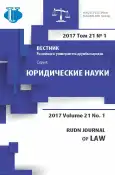Механизм конституционного правотворчества в США как проявление конвергенции в праве
- Авторы: Петрова Е.А.1
-
Учреждения:
- Ивановский государственный университет
- Выпуск: Том 21, № 1 (2017)
- Страницы: 28-52
- Раздел: Статьи
- URL: https://journal-vniispk.ru/2313-2337/article/view/343892
- DOI: https://doi.org/10.22363/2313-2337-2017-21-1-28-52
- ID: 343892
Цитировать
Полный текст
Аннотация
В статье рассматривается специфика механизма конституционного правотворчества в США в контексте сочетания различных форм правотворческой деятельности, в т.ч. свойственных разным правовым традициям. Уникальность американской правовой системы заключается в том, что она вобрала в себя черты как общего права, лежащего в ее основе, так и права континентального, приобретя тем самым комплексный характер. Конституционное правотворчество трактуется автором как осуществляемая компетентными правотворческими субъектами деятельность по созданию конституции как акта особого рода. При этом механизм конституционного правотворчества охватывает систему взаимосвязанных элементов (статический аспект) и последовательных стадий (динамический аспект), обеспечивающих создание и объективацию конституционных норм в форме соответствующего конституционного акта. Конвергенционный характер механизма конституционного правотворчества в США проявляется в двух аспектах. Первый аспект связан со спецификой принятия Конституции США. Так, в механизме конституционного правотворчества изначально был задействован инструментарий договорного правотворчества, однако результатом его стал не международный договор в его традиционном понимании, а нормативный правовой акт, обладающий высшей юридической силой. Второй аспект отражает дальнейшее развитие конституционных положений через внесение поправок в текст Конституции (что свойственно для континентальной конституционной традиции), а также и преимущественно через присущее общему праву судебное конституционное правотворчество. Последнее осуществляется через конституционные доктрины Верховного Суда США, с помощью которых конституционные нормы без формального изменения приобретают реальное звучание, соответствующее меняющимся социальным условиям. Делается вывод, что механизм конституционного правотворчества в США, обусловленный интеграционной природой американской правовой системы в целом, выступает проявлением конвергенции в праве, при которой из трех форм правотворческой техники - договорной, законодательной и прецедентной берутся самые действенные инструменты и достигается наиболее эффективный правовой результат.
Об авторах
Екатерина Алексеевна Петрова
Ивановский государственный университет
Автор, ответственный за переписку.
Email: kate_petrova78@mail.ru
ул. Ермака, 39, Иваново, Россия, 153025
Список литературы
- Tret'yakova OD. Yuridicheskaya konvergentsiya. Avtoreferat diss. [The legal convergence. Diss. abstract]. Vladimir; 2012. 44 p. (In Russian).
- Sinyukov VN. Mekhanizm pravotvorchestva. Avtoreferat diss. [The mechanism of law-making. Diss. abstract]. Saratov; 2013. 26 p. (In Russian).
- Romashov RА, editor. Teoriya gosudarstva i prava [The Theory of State and Law]. Saint Petersburg: ''Yuridicheskii tsentr Press''; 2005. 630 p. (In Russian).
- Petrova EA. Judicial Lawmaking Mechanism: Definition and Peculiarities. Journal of Foreign Legislation and Comparative Law. 2016;3(58);16–23. (In Russian). doi: 10.12737/20571.
- Nevins A, Commager HS. Istoriya SShA: Ot angliiskoi kolonii do mirovoi derzhavy [The His-tory of the United States: from the British Colony to the World Power]. New York: Teleks; 1991. 442 p. (In Russian).
- Krashenninikova NA, Zhidkov OA, editors. Istoriya gosudarstva i prava zarubezhnykh stran [History of State and Law of Foreign Countries]. Part 2. Moscow: NORMA; 1999. 712 p. (In Russian).
- Mishina AA, Yaz'kova EF, editors. Konstitutsiya SShA: Istoriya i sovremennost' [The Consti-tution of the United States: History and Modernity]. Moscow: Yuridicheskaya literatura; 1988. 320 p. (In Russian).
- Konstitutsiya SShA [The Constitution of the United States]. Moscow: TOO ''Ivan''; 1993. 32 p. (In Russian).
- Lafitsky VI. Constitutional system of the USA. 2nd ed. Moscow: Statut; 2011. 349 р. (In Rus-sian).
- The Constitution of the United States. Washington: OSC; 1987. 44 p.
- Chirkin VE. Konstitutsionnoe pravo zarubezhnykh stran [The Constitutional Law of Foreign Countries]. Moscow: Yurist"; 1999. 568 p. (In Russian).
- Mishin AA. Gosudarstvennoe pravo SShA. Moscow: Nauka; 1976. 207 p. (In Russian).
- Geevskii IA, editor. SShA: konstitutsiya i prava grazhdan [State law of USA.]. Moscow: Mysl'; 1987. 317 p. (In Russian).
- SShA: Ekonomicheskii spravochnik [USA: Economic Handbook]. Moscow: Politizdat; 1988. 390 p. (In Russian).
- David R, Jauffret-Spinosi C. Les grands systèmes de droit contemporains. 10 ed. Paris: Dalloz; 1992. (In French). [Russ. ed. David R, Jauffret-Spinosi C. Osnovnye pravovye sistemy sovremennosti. Moscow: Mezhdunarodnye otnosheniya; 1999. 400 p.].
- Bernstein RB. Amending America: if we love the Constitution so much, why do we keep trying to change it? New York: Times Books; 1993. 392 p.
- Zhidkov OA. Verkhovnyi sud SShA: Pravo i politika [The U.S Supreme Court: Law and Poli-tics]. Moscow: Nauka; 1985. 224 p. (In Russian).
- Miller AS. The Supreme Court: Myth and Reality. Westport: Greenwood Press; 1978. 370 p.
- Sergeeva SL. Razvitie konstitutsionnogo sudebnogo pravotvorchestva v SShA (konets XIX – nachalo XXI vv). Diss. kand. yuridich. nauk. [The Development of Law-making of the Consti-tutional Court in the United States (end of XX - beginning of XXI centuries) Cand. legal sci. diss.]. Kursk; 2012. 208 p. (In Russian).
- Kramer L.D. The Supreme Court 2000 Term – Foreword: We the Court. Harvard Law Review. 2001;115(1):4–169.
- Holmes OV. The Common Law. Cambridge, Massachusetts: Belknap Press of Harvard Uni-versity Press; 2009. xliv, 393 p.
- Friedman LM. American Law. Moscow: Izdatel'skaya gruppa «Progress»; 1992. 286 p. (In Russian).
- Mikula MF,. Mabunda LM, McClintic MA, editors. Great American Court Cases. Vol. III: Equal Protection and Family Law. Detroit, San Francisco, L.: Gale Group; 1999. 728 p.
- Vlasikhin V. Fenomen Verkhovnogo suda SShA: Amerikanskii areopag v pervom dome na pervoi ulitse [The phenomenon of the U.S Supreme Court: American Areopagus at the First house on the First Street]. Russian Justitia. 2000;11:55-58. (In Russian).
- Franlovsky S, Goldman R, Lentovska E. Supreme Court of the USA about Civil Rights and Freedoms. Poland: BEGA; 1996. 254 p. (In Russian).
- Bogdanovskaya IJ. Istochniki prava na sovremennom etape razvitiya «obshchego prava». Diss. [Sources of law at the present stage of the development of "common law". Dissertation]. Moscow; 2007. 338 p. (In Russian).
- Killian JH, Beck LE, editors. The Constitution of the United States of America: Analysis and Interpretation. Washington, D.C.: U.S. Government Printing Office; 1987. 2308 p.
Дополнительные файлы









